“The Kaleidoscope… is an instrument for creating and exhibiting an infinite variety of beautiful forms… to please the eye by an ever-varying succession of splendid tints and symmetrical forms” wrote Sir David Brewster about his marvelous invention.

Brewster (1781-1868) was an inventor, scientist and natural philosopher from Scotland. He invented the kaleidoscope in 1813 and filed for a patent shortly thereafter. The official records show: “Specification of the Patent granted to DAVID BREWSTER, of Edinburgh, Doctor of Laws; for a new Optical Instrument, called ‘The Kaleidoscope,’ for exhibiting and creating beautiful Forms and Patterns, of great use in all the ornamental Arts. Dated July 10, 1817.”
 After describing the instrument’s construction, Brewster builds his case by explaining the kaleidoscope would “enable the observer to render permanent such as may appear most appropriate for any of the numerous branches of the ornamental arts”. He goes on to say, “It would be an endless task to point out the various purposes in the ornamental arts to which the Kaleidoscope is applicable. It may be sufficient to state, that it will be of great use to architects, ornamental painters, plasterers, jewellers, carvers and gilders, cabinet-makers, wire-workers, book-binders, calico-printers, carpet manufacturers, manufacturers of pottery, and every other profession in which ornamental patterns are required.”
After describing the instrument’s construction, Brewster builds his case by explaining the kaleidoscope would “enable the observer to render permanent such as may appear most appropriate for any of the numerous branches of the ornamental arts”. He goes on to say, “It would be an endless task to point out the various purposes in the ornamental arts to which the Kaleidoscope is applicable. It may be sufficient to state, that it will be of great use to architects, ornamental painters, plasterers, jewellers, carvers and gilders, cabinet-makers, wire-workers, book-binders, calico-printers, carpet manufacturers, manufacturers of pottery, and every other profession in which ornamental patterns are required.”

“The painter may introduce the very colours which he is to use, the jeweller the jewels which he is to arrange, and in general the artist may apply to the instrument the materials which he is to embody, and thus form the most correct opinion of their effect when combined into an ornamental pattern. When the instrument is thus applied, an infinity of patterns are created, and the artist can select such as he considers most suitable to his work.”
 If you’ve ever marveled at the play of light, color and pattern in a kaleidoscope, you’ll understand why making your own artisan kaleidoscope can be very appealing. It’s why I jumped at the chance to join the kaleidoscope-making class, A Journey into the Universe, taught by Scott Cole at the John C Campbell Folk School.
If you’ve ever marveled at the play of light, color and pattern in a kaleidoscope, you’ll understand why making your own artisan kaleidoscope can be very appealing. It’s why I jumped at the chance to join the kaleidoscope-making class, A Journey into the Universe, taught by Scott Cole at the John C Campbell Folk School.
All the images shown thus far in this blog post were seen in the first kaleidoscope I made in the class. I’ve dubbed it “My Festive Kaleidoscope” because of the red and green color palette.
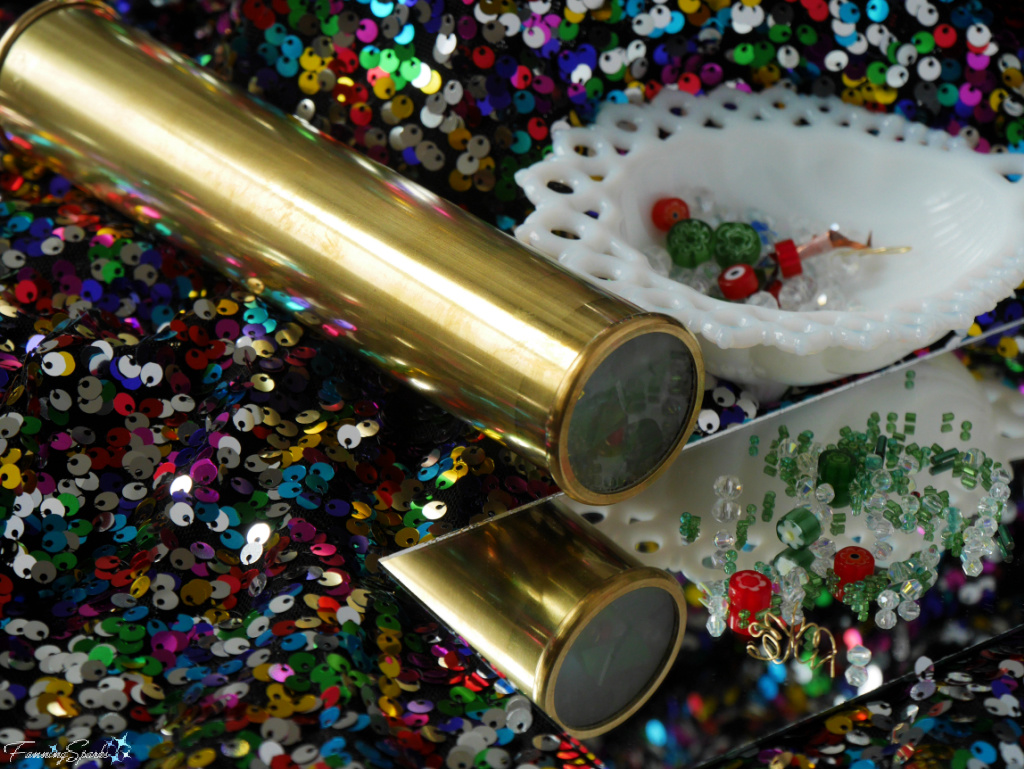
A kaleidoscope is made “with two or more reflecting surfaces (or mirrors) tilted to each other at an angle, so that one or more (parts of) objects on one end of these mirrors are shown as a regular symmetrical pattern when viewed from the other end, due to repeated reflection. These reflectors are usually enclosed in a tube, often containing on one end a cell with loose, colored pieces of glass or other transparent (and/or opaque) materials to be reflected into the viewed pattern. Rotation of the cell causes motion of the materials, resulting in an ever-changing view being presented.” as described by Wikipedia.
Here are the basic components I prepared for my kaleidoscope. Missing from the photo are the pretty bits and pieces, aka the “magic”, for the object chamber.
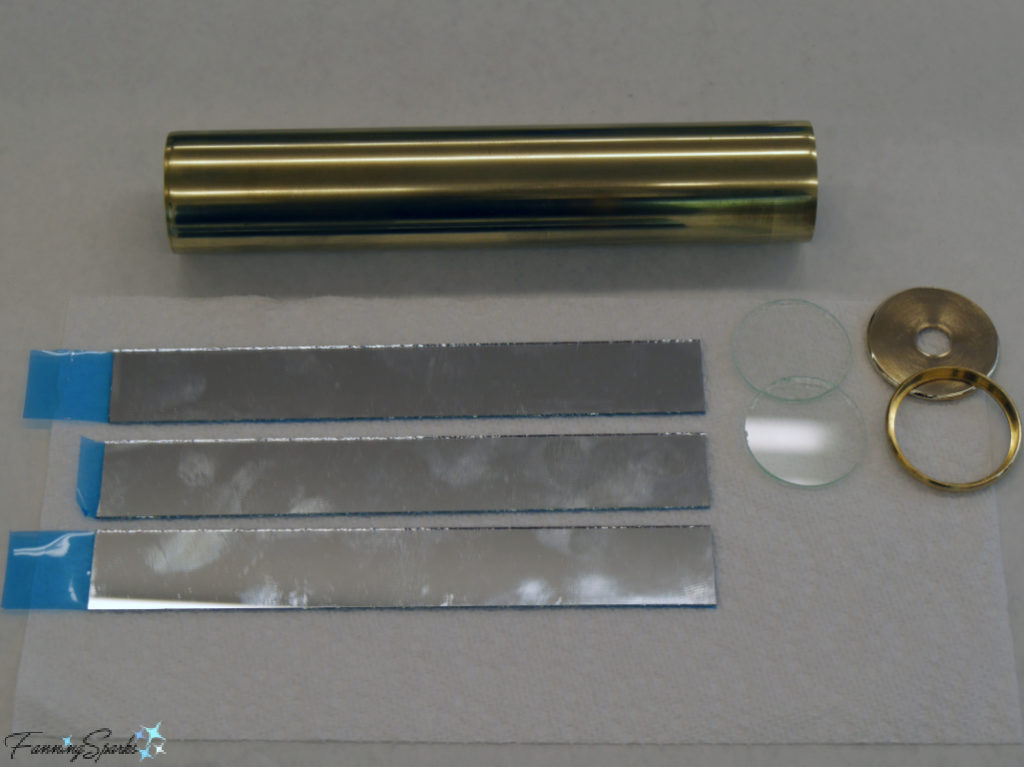 We used three mirrors in a 60°-60°-60° equilateral triangle configuration. It’s important to point out, we used front surface mirrors for our kaleidoscopes. “Ordinary mirrors are not suitable for a quality scope as they do not provide clear, sharp reflections. First- or front- surface mirrors that have a reflective coating on their front surface are essential for first-rate viewing. Light reflects only once from such a mirror, which gives a sharper image. Regular mirrors are coated on the rear surface, so that light is reflected twice, leaving the edges of the images fuzzy.” explains author Cozy Baker in her 1993 book Kaleidoscope Renaissance.
We used three mirrors in a 60°-60°-60° equilateral triangle configuration. It’s important to point out, we used front surface mirrors for our kaleidoscopes. “Ordinary mirrors are not suitable for a quality scope as they do not provide clear, sharp reflections. First- or front- surface mirrors that have a reflective coating on their front surface are essential for first-rate viewing. Light reflects only once from such a mirror, which gives a sharper image. Regular mirrors are coated on the rear surface, so that light is reflected twice, leaving the edges of the images fuzzy.” explains author Cozy Baker in her 1993 book Kaleidoscope Renaissance.
 When the front surface mirror strips are cut perfectly straight and flawlessly aligned, the kaleidoscope will produce a perfectly symmetrical, continuous, honeycomb-like, pattern across the entire field of view. If you examine my kaleidoscope images carefully, you may notice I didn’t quite perfect the mirror installation. Regardless, the images are stunning!
When the front surface mirror strips are cut perfectly straight and flawlessly aligned, the kaleidoscope will produce a perfectly symmetrical, continuous, honeycomb-like, pattern across the entire field of view. If you examine my kaleidoscope images carefully, you may notice I didn’t quite perfect the mirror installation. Regardless, the images are stunning!
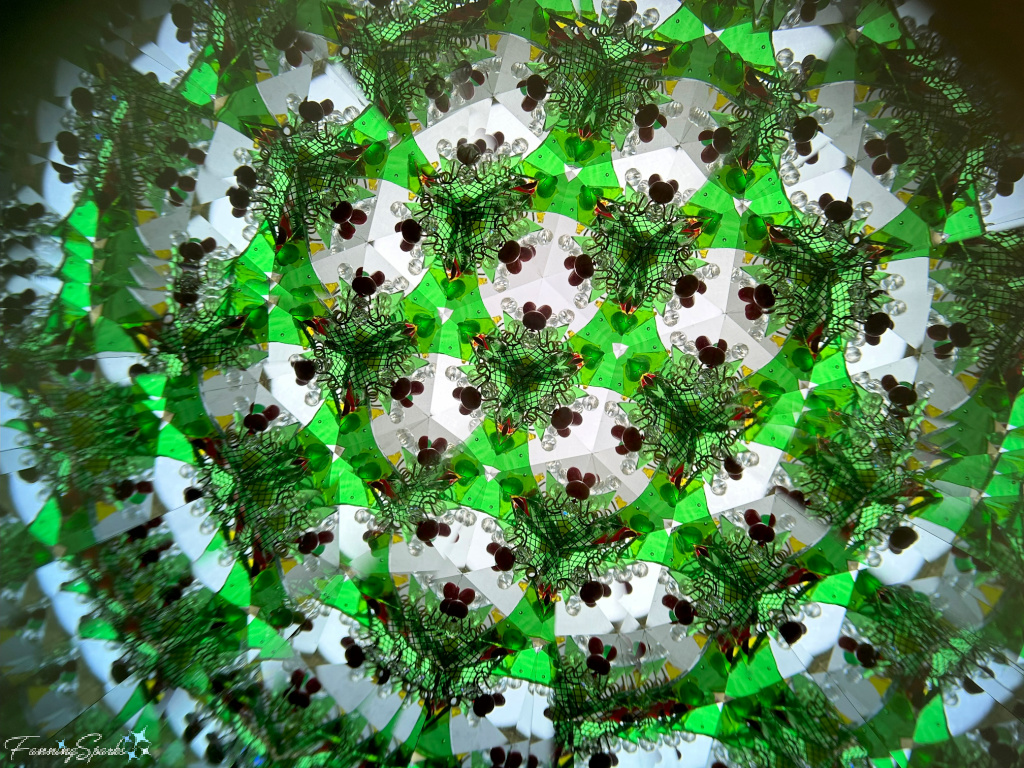 Not only are they beautiful but their variety is endless. “The property of the Kaleidoscope, which has excited more wonder, and therefore more controversy than any other, is the number of combinations or changes which it is capable of producing from a small number of objects.” explains Brewster in his 1819 book A Treatise on the Kaleidoscope.
Not only are they beautiful but their variety is endless. “The property of the Kaleidoscope, which has excited more wonder, and therefore more controversy than any other, is the number of combinations or changes which it is capable of producing from a small number of objects.” explains Brewster in his 1819 book A Treatise on the Kaleidoscope.
Brewster wrote his book to set the record straight after his patented idea for the kaleidoscope was stolen. He describes the situation this way: “in consequence of one of the Patent instruments having been exhibited to some of the London opticians, the remarkable properties of the Kaleidoscope became known, before any number of them could be prepared for sale. The sensation excited in London by this premature exhibition of its effects is incapable of description, … no fewer than two hundred thousand instruments have been sold in London and Paris during three months. Out of this immense number there is perhaps not one thousand constructed upon scientific principles, … and of the millions who have witnessed its effects, there is perhaps not an hundred who have any idea of the principles upon which it is constructed, [and] who are capable of distinguishing the spurious from the real instrument”. Not only was Brewster’s invention stolen but he missed out on considerable profits as the marketplace was flooded with knockoffs.
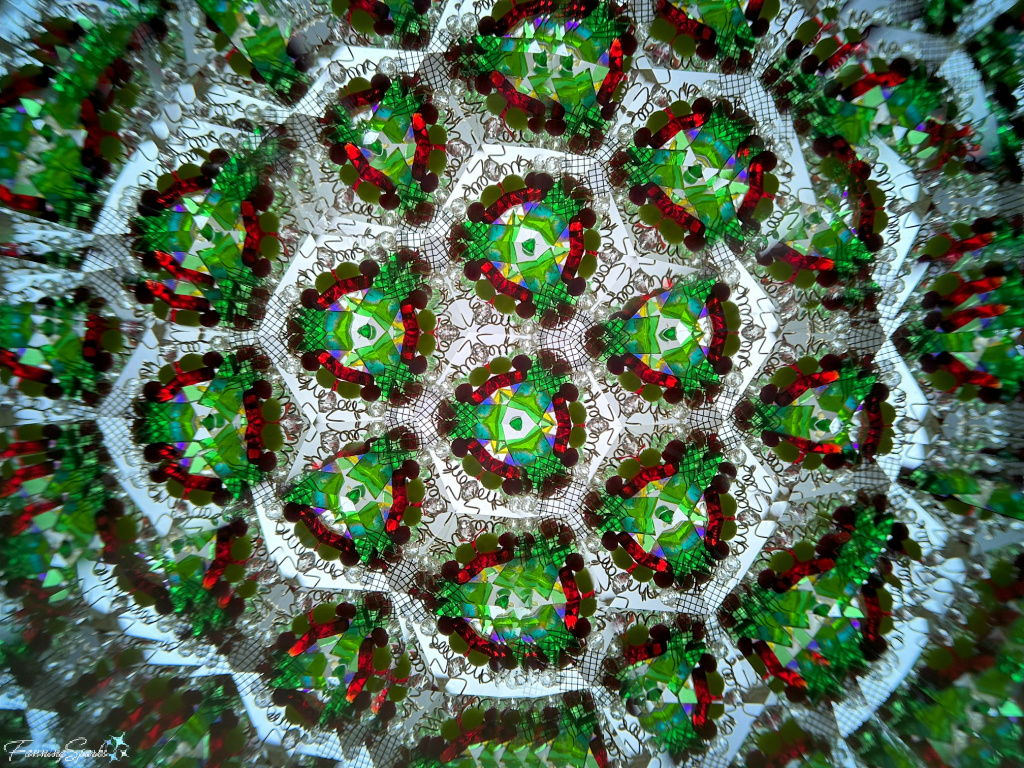 Returning to the topic of the number of images the kaleidoscope is capable of producing, Brewster explains “Many persons, entirely ignorant of the nature of the instrument, have calculated the number of forms which may be created from a certain number of pieces of glass, upon the ordinary principles of combination. In this way it follows, that 24 pieces of glass may be combined 1391724288887252999425128493402200 times, an operation, the performance of which would take hundreds of thousands of millions of years, even upon the supposition that 20 of them were performed every minute. This calculation, surprising at it appears, is quite false, not from being exaggerated, but from being far inferior to the reality.” He goes into great detail to support his argument that “With a number of loose objects, it is impossible to reproduce any figure which we have admired. When it is once lost, centuries may elapse before the same combination returns.” I’m in no position to validate his calculations but I can confirm that I’ve never seen the same image repeated in my kaleidoscope. It is, in fact, one of the most fascinating aspects of peering into a kaleidoscope.
Returning to the topic of the number of images the kaleidoscope is capable of producing, Brewster explains “Many persons, entirely ignorant of the nature of the instrument, have calculated the number of forms which may be created from a certain number of pieces of glass, upon the ordinary principles of combination. In this way it follows, that 24 pieces of glass may be combined 1391724288887252999425128493402200 times, an operation, the performance of which would take hundreds of thousands of millions of years, even upon the supposition that 20 of them were performed every minute. This calculation, surprising at it appears, is quite false, not from being exaggerated, but from being far inferior to the reality.” He goes into great detail to support his argument that “With a number of loose objects, it is impossible to reproduce any figure which we have admired. When it is once lost, centuries may elapse before the same combination returns.” I’m in no position to validate his calculations but I can confirm that I’ve never seen the same image repeated in my kaleidoscope. It is, in fact, one of the most fascinating aspects of peering into a kaleidoscope.
 There is an art to designing the kaleidoscope’s display. Anything small enough to fit in the object chamber can be included but, as we learned in class, each piece must be carefully considered for its color, shape, opacity and interest. Then the design must be considered in its totality for the overall composition and how the pieces interact.
There is an art to designing the kaleidoscope’s display. Anything small enough to fit in the object chamber can be included but, as we learned in class, each piece must be carefully considered for its color, shape, opacity and interest. Then the design must be considered in its totality for the overall composition and how the pieces interact.
Here’s a look at my second kaleidoscope which I’ve dubbed “Spring Kaleidoscope”.
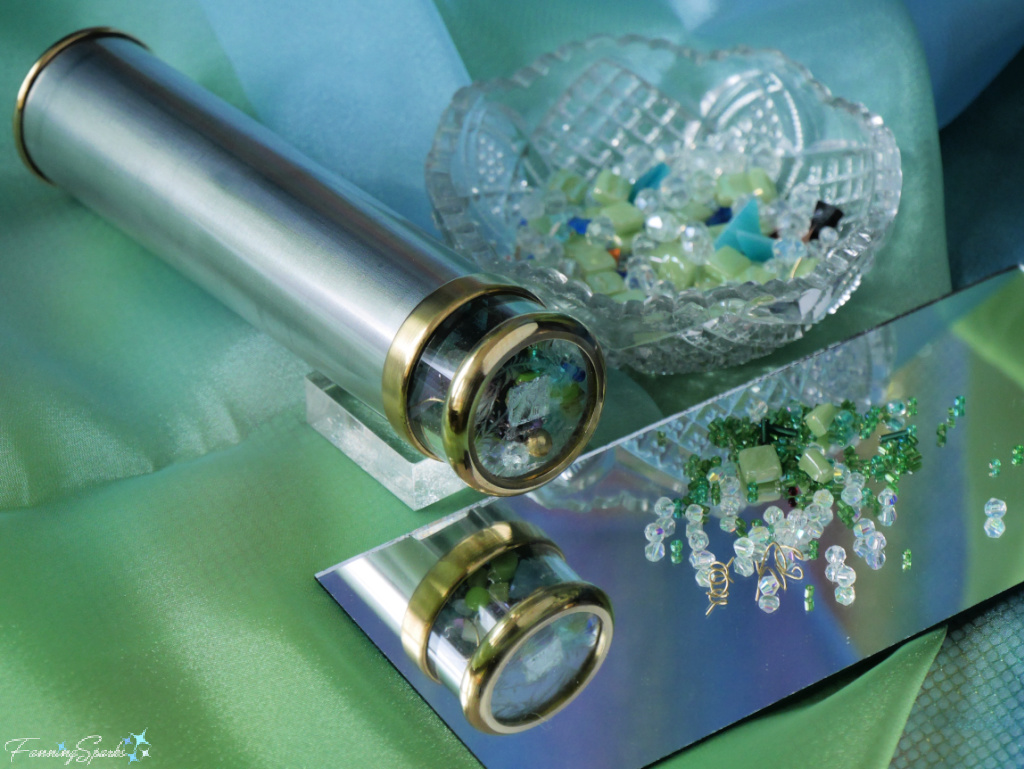 I chose a variety of items in a spring-colored palette for the display in this one. If you examine the dish pictured below carefully, you may notice small square fragments of mirror; bright green, opal and purple flameworked glass beads; a round gold bead; a spiral of brass wire; a long, straight, pink glass stringer; a curvy blue glass stringer; a small piece of brass-colored screen; teal seed beads; a twist of silver-colored metal; gold buckle-shaped beads; aqua bugle beads; a tiny flameworked daisy bead; green teal triangles of stained glass and so on. Special thanks to my classmate Caroline for sharing her treasure stash with me!
I chose a variety of items in a spring-colored palette for the display in this one. If you examine the dish pictured below carefully, you may notice small square fragments of mirror; bright green, opal and purple flameworked glass beads; a round gold bead; a spiral of brass wire; a long, straight, pink glass stringer; a curvy blue glass stringer; a small piece of brass-colored screen; teal seed beads; a twist of silver-colored metal; gold buckle-shaped beads; aqua bugle beads; a tiny flameworked daisy bead; green teal triangles of stained glass and so on. Special thanks to my classmate Caroline for sharing her treasure stash with me!
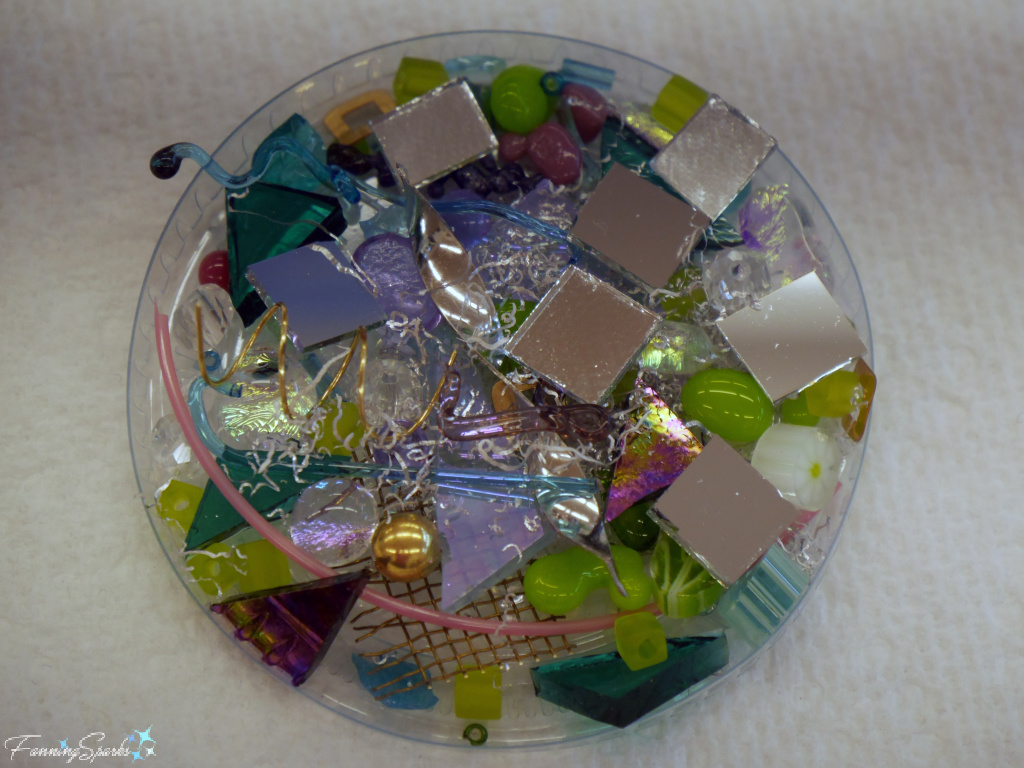 I didn’t include all of these items in my final design because I wanted to leave some white space and the pieces need to move freely. But the variety of items has resulted in an astonishing “number of combinations or changes”, as Brewster would say. Here are a few side-by-side images to illustrate the point.
I didn’t include all of these items in my final design because I wanted to leave some white space and the pieces need to move freely. But the variety of items has resulted in an astonishing “number of combinations or changes”, as Brewster would say. Here are a few side-by-side images to illustrate the point.
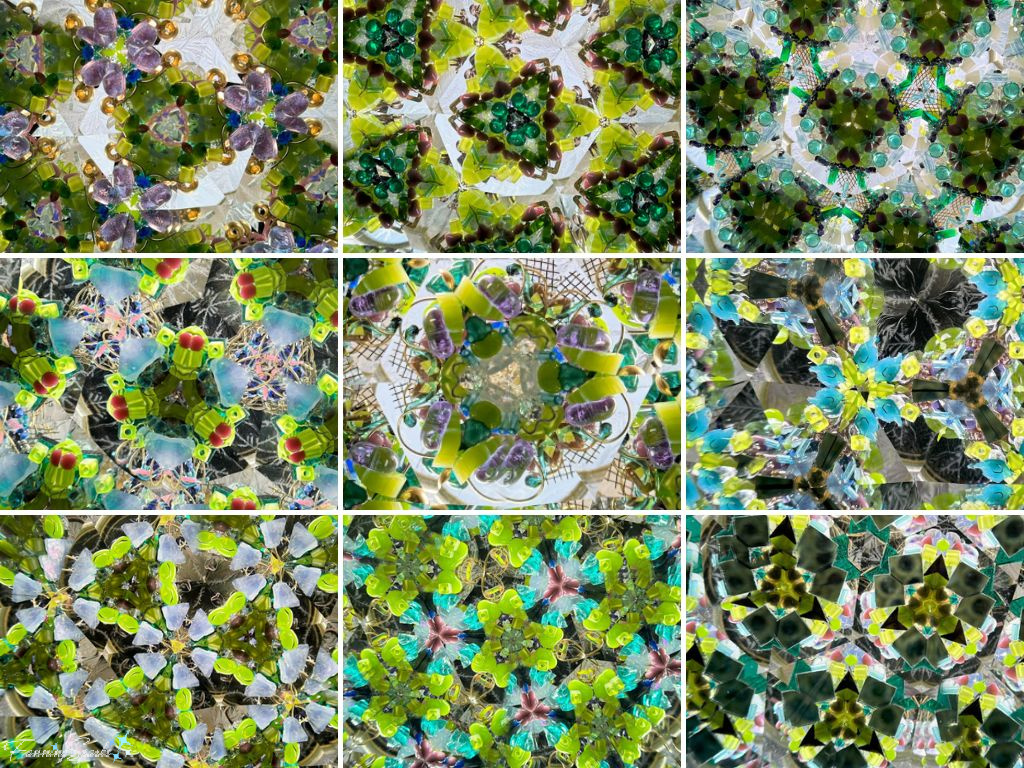 In addition to the variety of images the kaleidoscope can display, the kaleidoscope housing can be created from a variety of materials in a variety of designs. There are also several different types of kaleidoscopes. A teleidoscope, for instance, has a clear lens which can be aimed at something of interest, such as flowers or landscapes, and turns it into a kaleidoscopic image.
In addition to the variety of images the kaleidoscope can display, the kaleidoscope housing can be created from a variety of materials in a variety of designs. There are also several different types of kaleidoscopes. A teleidoscope, for instance, has a clear lens which can be aimed at something of interest, such as flowers or landscapes, and turns it into a kaleidoscopic image.
Kaleidoscopes can be mounted on pedestals or held by hand. Their size can vary from miniature versions worn as a necklace to enormous, building-sized versions.
According to the Guinness World Records website, the world’s largest kaleidoscope is located in Nagoya, Japan. “The Nagoya City Pavilion ‘Earth Tower’ [built in 2005] … stands 47 m (154 ft) tall and projects a kaleidoscopic image 40 m (131 ft) across to viewers at the base of the triangular tower.” Back in 1997, the record was held by the Emerson Resort and Spa in New York state when they transformed a 60-ft farm silo into the “World’s Largest Kaleidoscope”.
Kaleidoscopes can have enclosed object chambers such as those we built in class. You may have noticed my first kaleidoscope has a hidden object chamber while my second kaleidoscope has a side lit chamber.
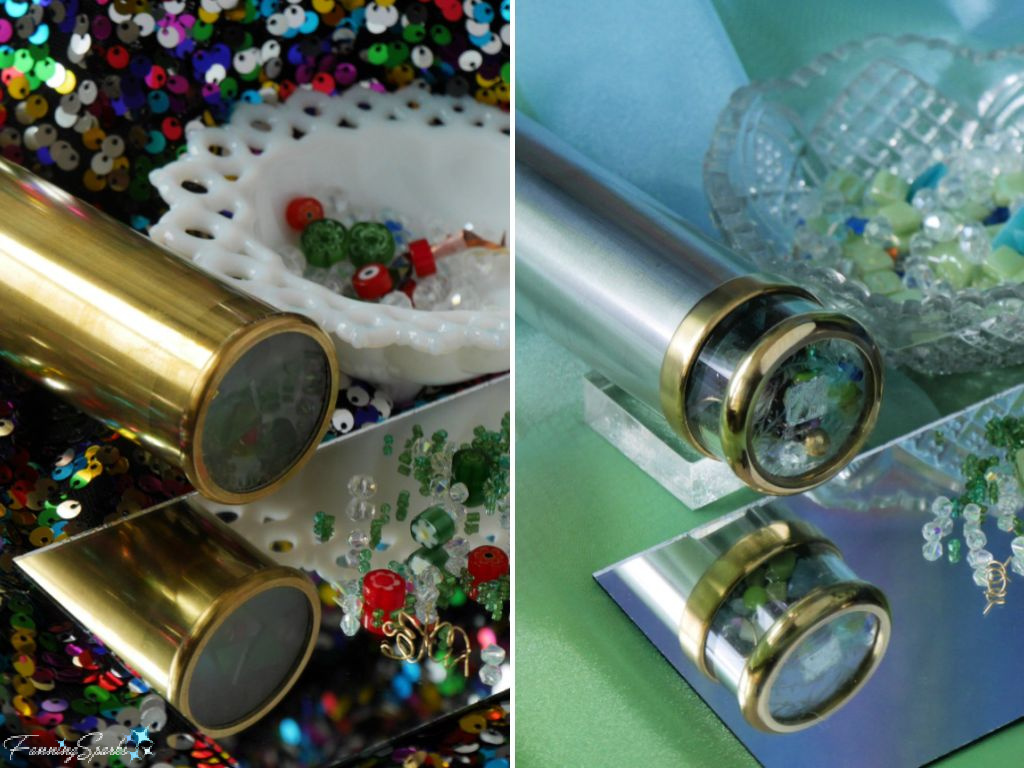 Shown below are several of Scott’s handcrafted, artisan kaleidoscopes which he shared with the class. Two of the kaleidoscopes, the aluminum tube and the blue suede-covered tube, have turning chambers which can be rotated separately from the main tube. A couple of the kaleidoscopes have mounted objects for viewing including a glass marble (shown bottom left) and a rainbow-colored spring (shown top left). There’s also a version which features objects floating in an oil-filled wand.
Shown below are several of Scott’s handcrafted, artisan kaleidoscopes which he shared with the class. Two of the kaleidoscopes, the aluminum tube and the blue suede-covered tube, have turning chambers which can be rotated separately from the main tube. A couple of the kaleidoscopes have mounted objects for viewing including a glass marble (shown bottom left) and a rainbow-colored spring (shown top left). There’s also a version which features objects floating in an oil-filled wand.
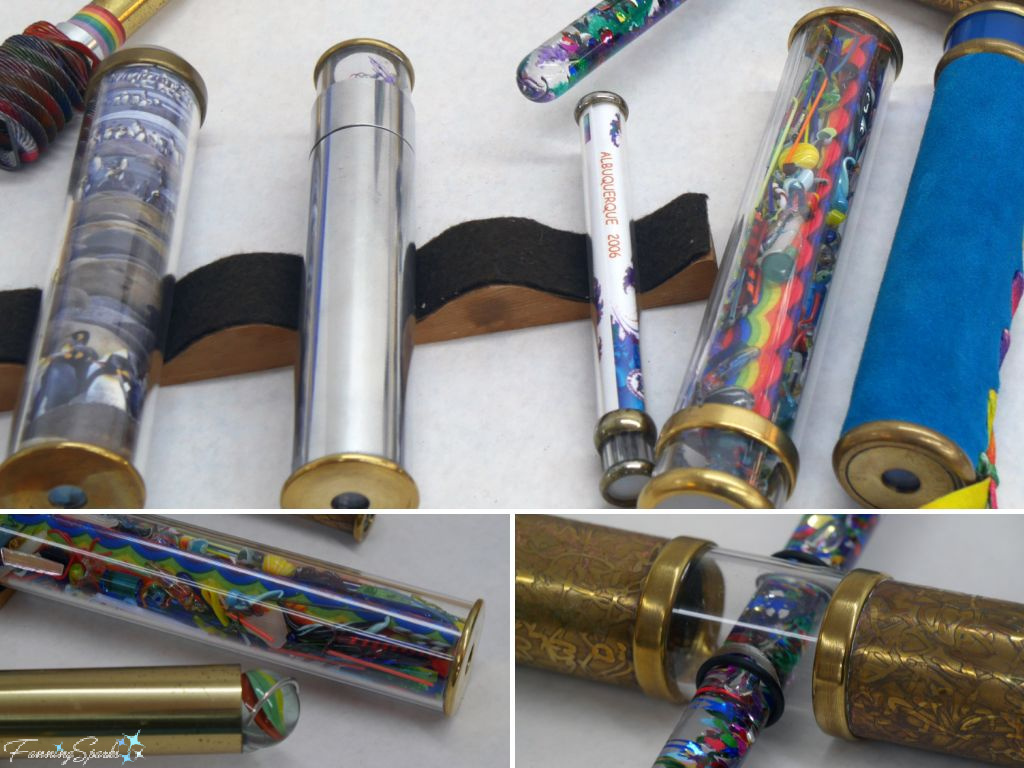 The kaleidoscopes we made during class were constructed with simple, metal tubes. My Festive Kaleidoscope is made from a 7½” piece of 1½” brass tubing while My Spring Kaleidoscope is made from a 6” piece of 1½” aluminum tubing. We only had time to polish the tubing but, given more time, there are a myriad of ways we could have embellished the metal tubes. It’s also possible to fashion tubes from other materials such as turned wood, stained glass, ceramic or acrylic.
The kaleidoscopes we made during class were constructed with simple, metal tubes. My Festive Kaleidoscope is made from a 7½” piece of 1½” brass tubing while My Spring Kaleidoscope is made from a 6” piece of 1½” aluminum tubing. We only had time to polish the tubing but, given more time, there are a myriad of ways we could have embellished the metal tubes. It’s also possible to fashion tubes from other materials such as turned wood, stained glass, ceramic or acrylic.
In fact, as Scott emphasized to the class, the objective is to build a kaleidoscope which is beautiful on the outside and the inside. I have a hunch Sir David Brewster would have agreed!
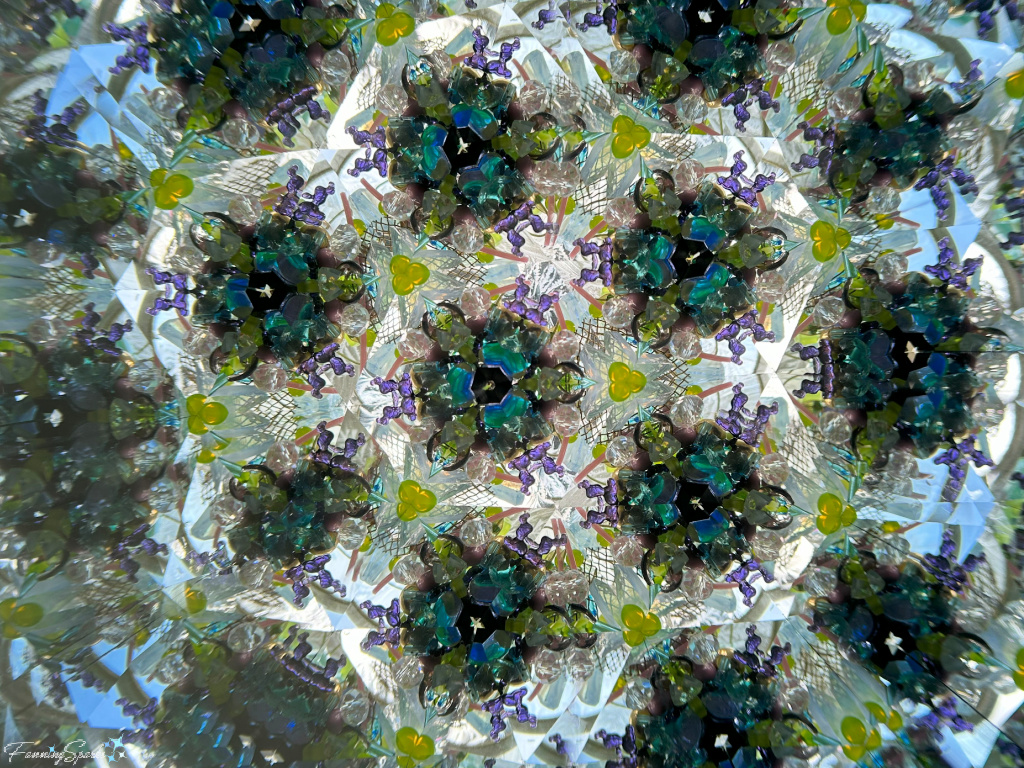
More Info
The kaleidoscope class, A Journey into the Universe, taught by Scott Cole was a weekend session held at John C Campbell Folk School.
“Scott has been designing innovative kaleidoscopes for over 25 years. He has shown his work in galleries and museums throughout the world and has been featured on television and in numerous books and articles. Scott has taught at the Folk School for over two decades, as well as at Penland School of Craft and other venues throughout the country and in Thailand and Japan.”
Scott’s kaleidoscope class was great fun! Not only did we make some incredible kaleidoscopes but we also gained the knowledge and confidence to create more on our own. That’s quite an accomplishment for a weekend class especially since kaleidoscopes require precision in a variety of skills from glass cutting to assembly. Scott was well-aware of the potential stumbling blocks and organized the class activities to minimize potential issues. For instance, he provided us with pieces of “practice” mirror so we could get familiar with the mirror assembly process in advance. Scott ensured everyone was able to complete their projects—explaining the process, demonstrating the steps, answering questions, assisting as needed, and, perhaps most importantly, reassuring and encouraging everyone along the way.
Many thanks to Scott and my fellow students for a great kaleidoscope-making experience!
Shown below is the D.X. Ross Jewelry and Metals Studio at the John C Campbell Folk School where our kaleidoscope class was held.
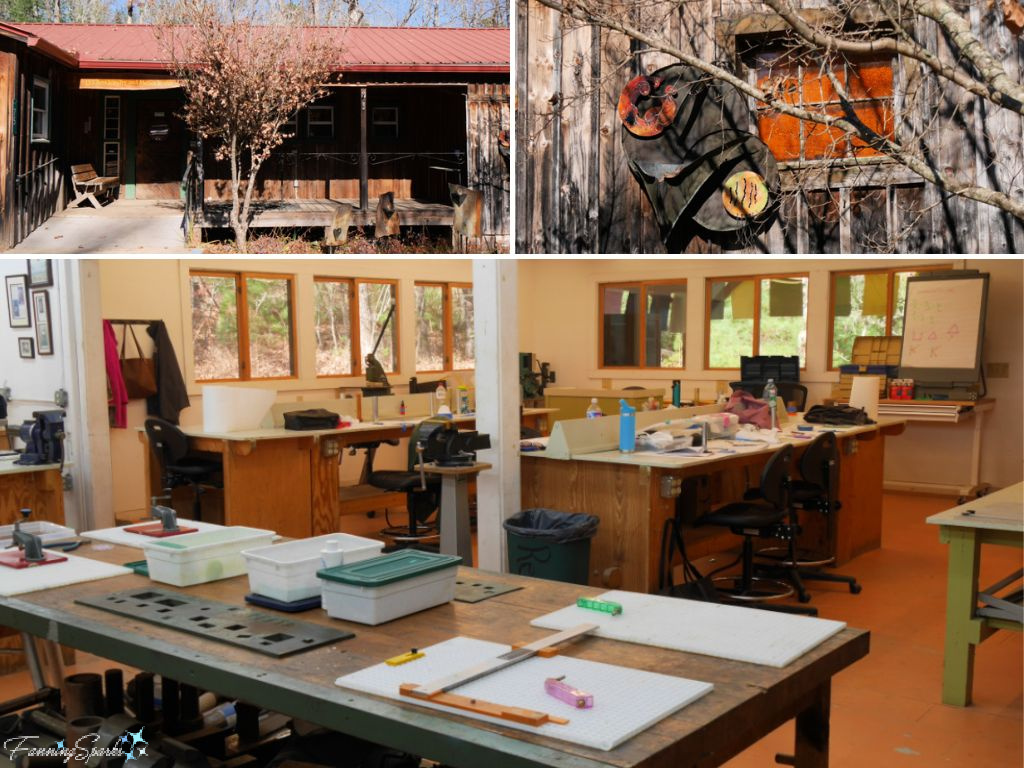 The John C Campbell Folk School, as described in the class catalog, “fosters a non-competitive learning environment where adults of all ages, skills and backgrounds learn from one another”. See the John C Campbell Folk School website for more info.
The John C Campbell Folk School, as described in the class catalog, “fosters a non-competitive learning environment where adults of all ages, skills and backgrounds learn from one another”. See the John C Campbell Folk School website for more info.
I recently participated in a 6-week Work Study Program at the John C Campbell Folk School. It was my third visit to the Folk School where I’ve had the opportunity to take a variety of classes from leathercrafting to basketry to broom making to pottery to woodcarving. I’ve shared these experiences here on the blog—they are all listed on the FanningSparks’ About > Folk School category index.
The following resources were consulted for this blog post:
. Repertory of Arts, Manufactures and Agriculture Consisting of Original Communications, Specifications of Patent Inventions, Practical and Interesting Papers; published in 1817. It is available here on Google Books.
. Kaleidoscope entry on Wikipedia
. Kaleidoscope Renaissance by Cozy Baker published in 1993. It is available here on Internet Archive.
. Kaleidoscopes: Wonders of Wonder by Cozy Baker published in 1999. It is available here on Internet Archive.
. A Treatise on the Kaleidoscope by David Brewster published in 1819. It is available here on Internet Archive.
. Largest Kaleidoscope Entry on the Guinness World Records website.
. World’s Largest Kaleidoscope article on the Emerson Resort and Spa website
. Kaleidoscopia! Book and Kit by Carolyn Bennett published in 2014. It is available here on Internet Archive.
. The Kaleidoscope Book: A Spectrum of Spectacular Scopes to Make by Thom Boswell published in 1995. It is available here on Internet Archive.
. The Scientific Nature of the Kaleidoscope article by Dawn Correia. Published in the Bulletin of the Scientific Instrument Society No 131 (2016). It is available here.
Today’s Takeaways
1. Sir David Brewster invented the kaleidoscope to exhibit and create beautiful forms and patterns.
2. With a number of loose objects, a kaleidoscope can display an inconceivable number of combinations or changes.
3. Artisans and makers strive to create kaleidoscopes which please the eye on both the inside and the outside.




2 Comments
@Marian, Thanks! Sir David Brewster knew what he was talking about! Peg
Amazing! Such beautiful images!